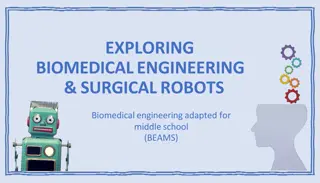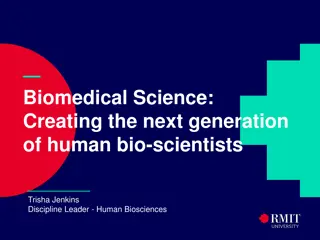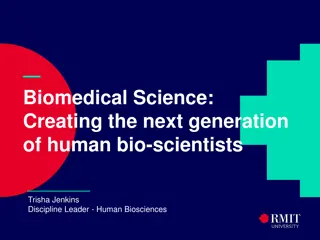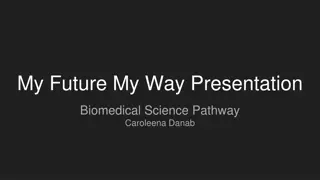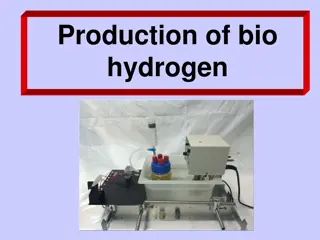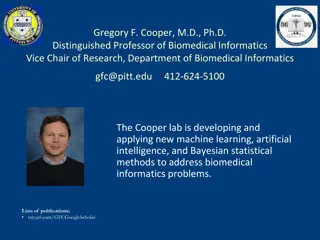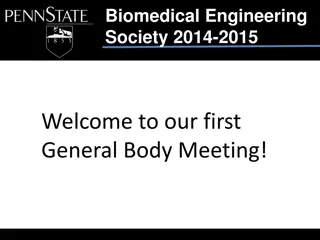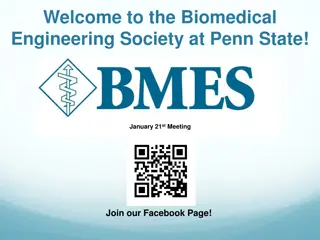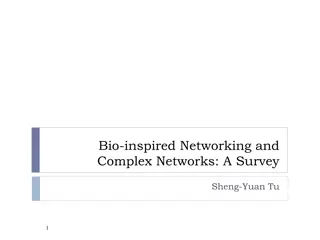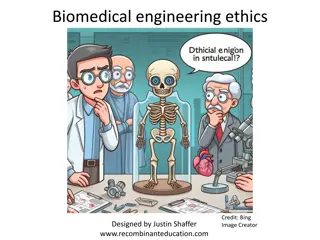Exploring Bionics and Bio-Microelectromechanical Systems in Biomedical Engineering
Delve into the fascinating world of bionics and bio-microelectromechanical systems in biomedical engineering, where nature's designs inspire technological innovations. Discover the applications, definitions, and principles shaping this field, along with the evolution of bionics from ancient times to modern advancements.
Download Presentation

Please find below an Image/Link to download the presentation.
The content on the website is provided AS IS for your information and personal use only. It may not be sold, licensed, or shared on other websites without obtaining consent from the author. Download presentation by click this link. If you encounter any issues during the download, it is possible that the publisher has removed the file from their server.
E N D
Presentation Transcript
: INTRO TO BIOMEDICAL ENGINEERING BIONICS & BIOMICROELECTROMECHANICAL SYSTEMS GROUP 2
TABLE OF CONTENT 1. 2. 3. 4. 5. 6. INTRODUCTION DEFINITIONS MAIN CONCEPTS AND PRINCIPLES MEDICAL APPLICATIONS DEVICES IDENTIFIED ADDRESSING LOCAL ISSUES IN BIOMEDICAL ENGINEERING AND HEALTHCARE WITH BIONICS AND BIO-MICROELECTROMECHANICAL SYSTEMS CONCLUSIONS REFERENCES GROUP MEMBERS 7. 8. 9.
INTRODUCTION The word bionic was coined by Jack E. Steele in 1958, possibly originating from the Ancient Greek term bion , meaning 'unit of life' and the suffix -ic , meaning 'like' or 'in the manner of . The roots of bionics could further be traced to even earlier scientific works such as Leonardo da Vinci s designs for gliding and flapping machines based on his anatomical study of birds. [1]
INTRODUCTION Bionics is one field of biomedical engineering which aims at analysing biological systems and transferring the underlying principles procedures, developments and phenomena in nature into technical implementations. Bio-MEMS, also an applicable field in bionics is centered on mechanical parts and microfabrication technologies made suitable for biological applications..
DEFINITIONS Bionics is the application of biological methods and systems found in nature to the study and design of engineering systems and modern technology. [2] Examples of bionics in engineering include robotics, medical adhesives, hulls of boat, imitating the thick skin of dolphins; sonar, radar, medical ultrasound imaging imitating animal echolocation just to mention a few. Bio-MEMS is the science and technology of operating at the microscale for biological and biomedical applications, which may or may not include any electronic or mechanical functions.[3]
MAIN CONCEPTS AND PRINCIPLES SCIENTIFIC CONCEPTS BIOMIMICRY This is the imitation of the models, systems, and elements of nature for the purpose of solving complex human problems.[4] For example the modelling of medical adhesives from the limbs of a gecko.
EVOLUTIONARY TRENDS This can be defined as a persistent, directional change in a character state, or set of character states, resulting in a significant change through time.[5] Over time, man, animals and processes in nature have either undergone progressive or repressive changes in their genetic makeup, bodily and physiological function.
MATHEMATICAL CONCEPTS PARTICLE SWARM OPTIMIZATION (PSO) It is currently one of the most powerful techniques used in optimization. It was inspired by the collective behavior of social animals, such as information circulation observed in bird flocks and fish schools.
Particle swarm optimization Fig. 1. Particle Swarm Optimization (n.d.).
A swarm is a population of homogenous, simple agents performing rather elementary tasks and interacting locally among themselves, and their environment, with no central control, such that a collective behavior emerges as a consequence of self-organization and local interactions.
APPLICATIONS PSO is therefore a population-based algorithm capable of producing low cost, fast, and robust solutions to several complex problems such as detecting at an early stage the critical conditions of a patient, affected by a specific disease using a remote health care system for patients at home.[6] PSO simply optimizes the symptoms for accurate diagnosis.
ARFTIFICIAL IMMUNE SYSTEM The immune system (IS) provides protection to a living body against a number for foreign molecules called antigens such as viruses, bacteria, fungi and other parasites. The Immune System possesses an excellent ability to recognize these foreign molecules, when they are encountered for the very first time, retain its memory of them and then identify them when encountered at a later stage.
The Artificial Immune System (AIS) is actually based on these capabilities of the immune system such as robustness, de-centralization, error tolerance and adaptiveness. Following the patterns and behaviours of the IS, three basic computational areas are developed such as : Immune modelling, Theoretical AIS and Applied AIS. [7]
APPLICATIONS AIS are used to solve several problems of the field such as; computer security, adaptive control systems, data analysis, bioinformatics, image processing and robotics. [8] In the development of BioMEMS (Bio Micro- Electro Mechanical Systems), it would be possible to install and deploy a large number of micro and nano sized robots capable of learning new skills, and adapting to new environments with the use of AIS
DESIGN CONCEPTS Bionics focuses on mimicry of natural systems and structures in the fields of design, utilising principles such as: 1. The Aalborg bio-inspired design method 2. The biomimicry design method
Table 1. The Aalborg bio-inspired design method (Colombo, 2007). Phase Description Choice and analysis of a natural system. The purpose of this phase is to understand the form, structure and functional principles of the natural system 1. Analysis Extrapolation of mathematical, geometrical and statistical principles through a process of abstraction and simplification. Transformation, by the analysis of the analogy, of the characteristics of the biological system into technical and mechanical terms. 2. Transformation Implement the principles of the relationship between form and structure found in the natural system analysis, for the development of new products. 3. Implementation Development and evaluation of a new product taking the environmental and economic factors for all life stages of the product into account. 4. Product development
Table (Junior et al., 2002). Phase 1. Identification of need Description Identification of an unmet need in a satisfactory manner and that allows the satisfaction of a particular problem and accurately, for subsequent analysis of the environment in search of potential solutions. Practical process step involving the selection of samples in nature that fit the problem and the need at hand. Involves the search for samples in nature and some knowledge about the habitat of the samples to be collected and of the equipment to be used for the collection. Observation and analysis of the components of the morphological structure, functions and processes, of the distributions in time and space and of the relationship with the environment. Classification of the sample. 2. Selection and sampling 3. Observation of the sample
Through the information of functional analysis, morphology and structure, the designer has the capacity to start considering the possibility and feasibility of application of an analogy between the sample studied and the product to design. 4. Analogy of the natural system with the product Considering the feasibility of application of the sample characteristics to the design and from the functional, formal and structural analysis, as well as the needs and requirements of the proposed product, an analysis of the system is held at this stage. 5. Design implementation
MEDICAL APPLICATIONS In medicine, bionics means the replacement or enhancement of organs or other body parts by mechanical versions. Bionic implants differ from mere prostheses by mimicking the original function very closely, or even surpassing it.
IMPLANTS An implant is a man-made medical device manufactured to replace a missing biological structure, support a damaged biological structure, or enhance an existing biological structure. THE COCHLEAR IMPLANT The device for the hearing-impaired, the cochlear implant is a replacement for the damaged or dysplastic inner ear. Cochlear implants bypass the normal hearing process. They have a sound processor that resides on the outside of the skin, and worn behind the ear, which contains microphones, electronics, battery, and a coil which transmits a signal to the implant. The implant has a coil to receive signals, electronics, and an array of electrodes which is placed into the cochlea, to stimulate the cochlear nerve. [9]
Cochlear implant Fig.2 The cochlear implant. Blausen.com staff (2014).
PROSTHESES A prosthesis is an artificial device that replaces a missing body part, which may be lost through trauma, disease, or congenital conditions and is intended to restore the normal functions of the missing body part.[10]
THE i-LIMB The i-LIMB hand is a prosthesis controlled through the use of myoelectric signals, which use the muscle signal in the patient s residual arm to move around. Electrodes are placed at two pre-determined muscles sites, which pick up the muscle signal when the patient contracts his/her muscles. These signals are then sent to a microprocessor which causes the device to move. The i-LIMB hand has up to four different muscle triggers. The user is able to assign a grip to move the device to a certain position. [11]
The i-limb Fig.3 Everyday use of the i-limb (n.d.). Fig.4 i-limb functionality (n.d.).
Bio-MEMS in the medical field are also applied in the following areas: Diagnostic microsystems: It includes rapid point-of-care, systems on a chip, cell and molecule sorting and also DNA diagnostics. Surgical microsystems: Minimally Invasive Surgery (MIS), CAD assisted surgery (micro robotics). Therapeutic microsystems and prostheses: Drug and gene delivery, tissue augmentation and repair, bio-capsules, micro-invasive surgical systems.[12]
DEVICES ARTIFICIAL HEART An artificial heart is a mechanical device, about the size of an orange, that is connected to your heart or implanted in your chest to help or replace a failing heart. There are two types of artificial hearts: 1. A VENTRICULAR ASSIST DEVICE (VAD) An artificial heart that provides an extra ventricle (pumping chamber in your heart) to help to pump blood around your body
Fig.5 Comparing the total artificial heart to a human heart. (n.d.).
2.TOTAL ARTIFICIAL HEARTS (TAH): These are a mechanical substitute for your entire heart. They are put into your body after your heart has been removed. How Does An Artificial Heart Work? Blood enters an artificial heart from the left or right atrium. It is then pumped into the aorta (artery to your body) or pulmonary artery (artery to your lungs), depending on which side of your heart is being supported. An artificial heart is powered by either compressed air or electricity. A thin cable connects the pumping chamber to a portable control console that regulates the pump function. [12]
MYOELECTRIC TECHNOLOGY . They allow the control of prosthetic limbs through the firing of electrical signals from the muscles. They provide a high rate of motion and multiple function for prosthesis in the upper limb. There are 3 different attachment sites that use myoelectric technology; the shoulder, the elbow, and the wrist The prosthetic limb is wired with signal receptors that receive signals from either the muscles in the shoulder or in the upper arm for movement, depending on the extent of the amputation.[13]
MYOELECTRIC TECHNOLOGY Fig.6 Myoelectric Prosthesis (n.d.).
BIO-MEMS DEVICES MEMS INERTIAL SENSORS MEMS accelerometers are used in defibrillators and pacemakers. Some patients exhibit unusually fast or chaotic heart beats and thus are at a high risk of cardiac arrest or a heart attack. An implantable defibrillator restores a normal heart rhythm by providing electrical shocks to the heart during abnormal conditions. Also, some peoples hearts beat too slowly, and this may be related to the natural aging process or a genetic condition A normal pacemaker maintains a proper heart beat by transmitting electrical impulses to the heart at a fixed rate. Modern pacemakers employ MEMS accelerometers and are hence capable of adjusting heart rate in accordance with the patient s physical activity.
MICROFLUIDICS FOR DRUG DELIVERY Microfluidics deal with the flow of liquids inside micrometer-sized channels one of microfluidics main application, the Lab-On-a-Chip (LOC) can provide a platform for both drug synthesis and delivery. A microfluidic chip is a set of micro-channels etched or molded into a material (glass, silicon or polymer such as PDMS, for PolyDimethylSiloxane). The micro-channels forming the microfluidic chip are connected together in order to mix, pump, sort, or control the biochemical environment chip, and are connected to the outside by inputs and outputs pierced through the chip, as an interface for fluid exchange between the macro- and micro-world. The use of these chips reduces both pain and risk of side effects and brings further improvements in cost, user- friendliness, safety and portability.[14]
Other devices include: Microneedle arrays for transdermal drug delivery Microsurgical tools for manipulation and surgical intervention of very small bodily tissues.
ADDRESSING LOCAL ISSUES IN BIOMEDICAL ENGINEERING AND HEALTHCARE WITH BIONICS AND BMEMS REHABILITATION In Ghana, patients can be fitted with bionic arms in the event of amputation as a result of an ailment or accident. In our local setting, a device like the cochlear implant will be very helpful in correcting hearing defects in many, especially the aged.
DRUG DELIVERY Pain and fear are greatly associated with syringe needles [15], although many drugs cannot be taken orally but transdermally due to them either being destroyed in the digestive tract or immediately metabolized by the liver before they can act. Thus making them less attractive drug delivery option. Needles precisely engineered to penetrate the stratum corneum, the skin's primary transport barrier, without reaching the underlying nerve cells can painlessly deliver drugs into the dermis, from which the drug can access the circulatory system relatively quickly. With the microneedles made of tiny quantities of materials, their cost will be greatly reduced, creating affordability of drugs for the general public.
Microneedles Fig.8 Image of a microneedle drug patch (n.d.).
DIAGNOSTIC MICROSYSTEMS The introduction of diagnostic microsystems like the Lab-On-Chip at healthcare centers in Ghana, will be very beneficial in epidemiological studies conducted in the country due to the ease with which they can be operated and with their analyses capabilities comparable to those conducted in full analytical laboratories standard test tubes that store blood samples, whilst also reducing costs by requiring lower reagent volumes. [16] LOC technology research and development can be adapted in Ghana for the detection of microorganisms that cause locally common diseases such as malaria, tuberculosis and diarrhea. The technology requires only finger-prick blood samples, doing away with Such handheld diagnostic devices using LOC can rapidly analyze blood samples of patients and precisely detect various strains of HIV, thus allowing specified treatment plans which are more plans which are more effective to be used , also helping to minimize drug wastage and drug resistance.
CONCLUSION "If we surrendered to earth's intelligence, we could rise up rooted, like trees. Rainer Maria Rilke, Rilke's Book of Hours: Love Poems to God[17] In conlusion, it is necessary for us, as prospective engineers in the new age of medicine and beyond, to be conscious of the fact that bionics, acquainted with many diverse fields such as bio- microelectromechanical systems- is indeed fertile ground on which mankind can work hand in hand with nature- from a new age of prostheses to even the evolving world of bio-inspired algorithms- to sustain and positively advance our synergic existence as beings of Earth.
REFERENCES [1]Schmitt, O.H.(1969). Some interesting and useful biomimetic transforms. In: Proceedings of the Third international Biophysics Congress. August 29-September3, 1969. boston, MA, 297. [2] Esomba(2012)Twenty-first century's fuel sufficiency roadmap,Lulu.com [3] Steven S. Saliterman (2006). Fundamentals of bio-MEMS and medical microdevices. Bellingham, Wash., USA: SPIE The International Society for Optical Engineering. [4] Vincent, Julian F. V.; et al. (22 August 2006). "Biomimetics: its practice and theory". doi:10.1098/rsif.2006.0127. [5] McNamara (2006). volutionary Trends . John Wiley and Sons Ltd, Chichester, United Kingdom. [6] Chemometrics and Intelligent Laboratory Systems. Volume 149, Part B, 15 December 2015, Pages 153-165 [7]Dasguptaa D., Yua S, Nino F (2011) Recent Advances in Artificial Immune Systems: Modelsand Applications. Applied Soft Computing 11: 1574-1587.
REFERENCES [8]HartE, Timmis J (2008) Application areas of AIS: the past, present and future. Journal of Applied Soft Computing, 8: 191-201. [9] https://www.news-medical.net/?tag=/Cochlear-Implant [10]Tommasi T, Orabona F, Castellini C, et al. Improving control of dexterous hand prostheses using adaptive learning. IEEE Trans Robot 2013. [11]https://en.wikipedia.org/wiki/I-LIMB_Hand [12] http://amppob.com/baptist-health-implants-arkansas-first-total-artificial-heart/ [13] http://www.ottobockus.com/prosthetics/info-fornew-amputees/prosthetics- 101/myoelectric-prosthetics-101/.
REFERENCES [14]https://www.elveflow.com/microfluidic-tutorials/cell-biology-imaging-reviews-and- tutorials/microfluidic-for [15]J.G. Hamilton Needle phobia: a neglected diagnosis J. Fam. Pract., 41 (1995), pp. 169-175 [13]R.H. Champion, J.L. Burton, F.J.G. Ebling Textbook of Dermatology Blackwell Scientific, Boston (1991) [16]https://www.news-medical.net/life-sciences/Health-Applications-of-Lab-on-a-Chip.aspx [17] Rilke(1905). Rilke's Book of Hours: Love Poems to God.Insel-Verlag, Germany
Particle Swarm Optimization [Digital Image]. (n.d.). Retrieved from https://www.slideshare.net/raafiubrian/particles-swarm-optimization Blausen.com staff (2014). "Medical gallery of Blausen Medical 2014". WikiJournal of Medicine 1 (2). DOI:10.15347/wjm/2014.010 Everyday use of the i-limb [Digital Image]. (n.d.). Retrieved from http://www.pinsdaddy.com/tester-pediatric- myoelectric-prosthetic-hands/ i-limb functionality [Digital Image]. (n.d.). Retrieved from http://www.touchbionics.com/products/how-i-limb- works Comparing the total artificial heart to a human heart. [Digital Image]. (n.d.). Retrieved from http://www.businessinsider.com/mechanical-hearts-could-replace-human-ones-2015-11?IR=T Myoelectric Prosthesis [Digital Image]. (n.d.). Retrieved from http://www.businessinsider.com/mechanical-hearts-could-replace-human-ones-2015/ http://slideplayer.com/slide/4304724/ Some Bio-MEMSs and their Applications [Digital Image]. (n.d.). Retrieved from https://en.wikipedia.org/wiki/Bio-MEMS#/media/File:Transdermal_microneedles.png Image of a microneedle drug patch [Digital Image]. (n.d.). Retrieved from
GROUP MEMBERS NAME ID NUMBER 10603856 10624934 10618133 10628119 10610509 QUANSAH EDWARD SAMUEL CHRISTIAN ADJEI FERNANDA-MARIE TETTE GEORGE HANSON ADU ISAAC YIRENKYI





